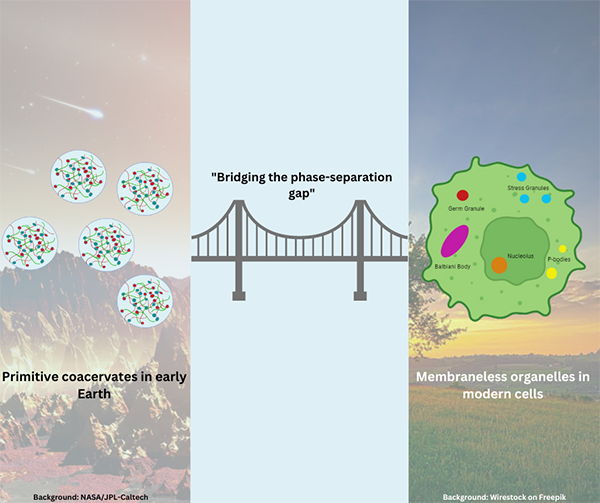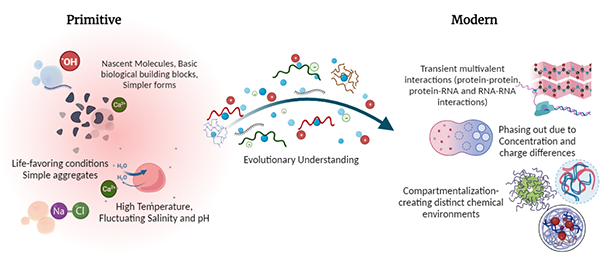Coacervate droplets are one form the first cells could have taken on early Earth. These droplets are formed via a phenomenon called liquid-liquid phase separation (LLPS), which also forms membraneless subcellular organelles that modulate cellular functions. Six early career researchers, mentored by Specially Appointed Associate Professor Tony Z. Jia of the Earth-Life Science Institute (ELSI) at Tokyo Institute of Technology, worked together to shed light on the compositional similarities and differences between primitive and modern LLPS. This study will hopefully serve as a basis to explore how primitive coacervates originated and evolved into modern membraneless organelles and/or membrane-bound cells.

The aggregation of simple biomolecules on early Earth gave rise to complex subunits, which began to interact with each other, constantly evolving into more complex biological systems, and finally giving rise to modern cells. One such physical process that may have contributed to the origins of life is liquid-liquid phase separation (LLPS), which also plays a role in modern biology. To understand how LLPS contributed to the formation of primitive biological systems, a group of early career researchers from Blue Marble Space Institute of Science (BMSIS), some of whom were part of the 2022 Young Scientist Program (YSP), mentored by Prof. Tony Z. Jia of ELSI, recently published a review article in Peptide Science comparing modern with primitive LLPS.
Among several different protocell models, coacervates can be generated from LLPS through the interaction of oppositely charged polyions, many of which could have been formed on early Earth (i.e., peptides and nucleic acids). Thus, coacervates were used as the primitive membrane protocell model within this study. Coacervates can show a number of essential functions relevant to early life, such as compartmentalization, which aids in prebiotic chemical synthesis, breakdown, and processing. In addition, at the molecular level, factors like pH, temperature, solvent environment, and salinity can influence coacervate structure. Given the varied environmental conditions on early Earth (such as regions of various temperatures, pH, etc.), it is very likely that specific environments were more favourable for primitive coacervate assembly.
In particular, as all modern organisms likely originated from primitive cells, understanding if membraneless protocells such as coacervates could have evolved to give rise to modern cells is highly relevant. Biological condensates are present in all living cells as membraneless organelles and function to regulate and direct biological processes and form through multivalent interactions between biomacromolecules, similar to coacervates. In particular, RNA and intrinsically disordered proteins (IDPs) (which don’t have an ordered structure like most proteins) are major players in biological condensate assemblies. The physical, structural, and biological properties of biological condensates can be modulated through variations in IDP/RNA constituents; one noteworthy example that can be used to support this principle is the “sticker and spacer” model, which provides rules as to the structure and assembly of different IDP-based LLPS. For instance, the interactions between stickers that allow for a faster cross-link lead to more rapid phase separation. However, aberrant forms of LLPS can also lead to neurodegeneration or even tumorigenesis, making it critical to study the mechanisms behind this complex process to support therapeutic interventions for LLPS-related illnesses.
Given that the constituents of both primitive and modern LLPS systems are similar, both containing components such as proteins, peptides, and nucleic acids, it is reasonable to consider whether there is a compositional evolutionary link between primitive and modern LLPS. In particular, there has been a recent rise in the development of membraneless organelle-inspired coacervates, bringing these seemingly dissociated research areas, i.e., modern and primitive phase separation, closer. Thus, this review expands this idea further to acquire novel insights into the connection between primitive and modern phase separation. In particular, the authors decided to compare compositional aspects (amino acid composition and peptide length) of primitive coacervates with those of modern LLPS. The researchers described how certain amino acids in modern LLPS could have also contributed to primitive LLPS assembly. Similarly, since short peptides were abundant on Early Earth (with some exceptions) due to the absence of an efficient biological peptide production machinery, this indicates that primitive coacervates were likely to be formed by shorter peptides on early Earth.
In addition to compositional comparison, the authors investigated other aspects of primitive coacervates. In particular, semi-permeable cellular and subcellular membranes in modern cells partition biomolecules, arrest biomolecular diffusion, and control their entry/exit. However, coacervates did not have a membrane, and if coacervates were to have evolved into modern cells, then they necessarily must have acquired one at some point in history. Similarly, it has been shown that viruses and LLPS may be deeply intertwined in some cases, with some viruses even proliferating through the instigation of LLPS. The authors thus discuss how primitive coacervates can acquire a membrane and evolve into membrane-bound cells while also highlighting how viruses and coacervates might have co-evolved together.
The researchers believe this novel study will serve as a credible resource that both primitive and modern LLPS researchers can utilize to explore how primitive coacervates might have compositional and evolutionary links to biological condensates. However, this review is just a stepping stone to addressing multiple knowledge gaps in both primitive and modern phase separation, as comparative studies on aspects other than composition and evolution, such as structure and function, should also be conducted to empower subsequent advancements in both areas.
This research highlight was prepared by Arunava Poddar, Prachiti V. Vithole, and Tan Nguyen, with assistance from Selene M.C. Cannelli, Ritvik Gupta, and Tony Z. Jia.


| Journal | Peptide Science |
| Title of the paper | A Compositional View Comparing Modern Biological Condensates and Primitive Phase-separated Compartments |
| Authors | Selene M.C. Cannelli1,△,†, Ritvik Gupta1,†, Tan Nguyen1,†, Arunava Poddar1,†, Srishti Sharma1,†, Prachiti V. Vithole1,†, Tony Z. Jia1,2 |
| Affiliations | 1. Blue Marble Space Institute of Science, 600 1st Ave, Floor 1, Seattle, WA 98104, USA 2. Earth-Life Science Institute, Tokyo Institute of Technology, 2-12-1-IE-1 Ookayama, Meguro-ku, Tokyo 152-8550, Japan △ Current Affiliation: Earth-Life Science Institute, Tokyo Institute of Technology, 2-12-1-IE-1 Ookayama, Meguro-ku, Tokyo 152-8550, Japan†These authors contributed equally |
| DOI | 10.1002/pep2.24331 |
| Online published date | 30 August, 2023 |
